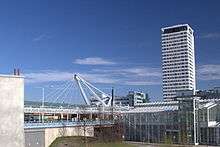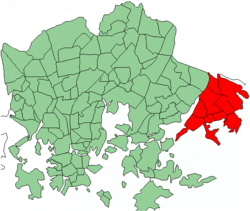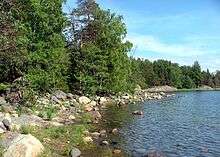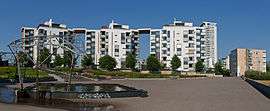Vuosaari
Vuosaari (Swedish: Nordsjö) is a neighbourhood in the City of Helsinki, Finland. It is located by the sea in East Helsinki and with its area of 15.38 km² is geographically the largest district in the city. It also has two Helsinki Metro stations, Rastila and Vuosaari

Vuosaari Nordsjö | |
|---|---|
 Position of Vuosaari within Helsinki | |
| Country | |
| Region | Uusimaa |
| Sub-region | Greater Helsinki |
| Municipality | Helsinki |
| District | Eastern |
| Subdivision regions | Meri-Rastila, Rastila, Keski-Vuosaari, Mustavuori, Niinisaari, Nordsjön kartano, Aurinkolahti, Kallahti |
| Area | 15.38 km2 (5.94 sq mi) |
| Population (2010) | 35,826 |
| • Density | 2,329/km2 (6,030/sq mi) |
| Postal codes | 00960, 00980, 00990 |
| Subdivision number | 54 |
| Neighbouring subdivisions | Marjaniemi, Puotila, Vartioharju, Mellunmäki |
Vuosaari is one of the fastest-growing areas in Helsinki. The number of inhabitants has been increasing rapidly since early 1990s and it continues to grow as new residential areas are being built. As of 2010, the population was 35,826.
Among other things, Vuosaari is noted for its nature and large, relatively unspoilt recreational seashore areas. One of these is Uutela, a popular nature park located in the southeastern corner of Vuosaari. The continual planning of new residential zones has in fact raised criticism, as many people would rather preserve Vuosaari's closeness to nature.

Vuosaari is the location of a new major seaport in Helsinki, the Vuosaari Harbour.
As of 2005, 7.7% of the population of Vuosaari are foreign citizens and 11.6% were born outside of Finland. This has given the neighbourhood an overtly multi-cultural image in Finnish folklore, even though the percentage is higher in many other places in the Capital Region.
The two natural gas power plants of Helsingin Energia, the power utility of the city of Helsinki, are located in Vuosaari.
History
Vuosaari has been populated continuously since the Iron Age. The first written record of the inhabitants of the area comes from a document dating back to Magnus IV of Sweden in the 14th century. By the 16th century, Vuosaari had regained its connection to the mainland and the former island had two Rustholl-mansions, Nordsjö and Rastböle respectively, several small villages and a military shipyard. Officers from Suomenlinna built houses on the peninsulas. This process was further amplified after a regular steam boat connection between Helsinki and Vuosaari was established in the 19th century. Of military historical interest is that Russians built fortifications here in 1917. During the Second World War, Vuosaari was used as a decoy Helsinki to divert the bombs away from the city. This was done by lighting bonfires and concentrating anti-aircraft guns on the island. Later, during the fast construction phase in the 1990s, this led to halts on building sites, as unexploded aerial bombs were discovered hidden in the ground.
After the war, most of the lands in Vuosaari were owned by Oy Saseka Ab, a brick and stone company that had its factory on the island. Big lots of underdeveloped land at a close proximity to the capital prompted Saseka to start a zoning and building process to increase the value of land there. The Asuntosäästäjät Union (lit. apartment-savers) started to build houses in the 1960s, thus creating what colloquially is now known as Old Vuosaari. Some of Finland's most famous architects participated in the planning, most notably Viljo Revell. Vuosaari was incorporated into Helsinki in 1966.

As the first real influx of refugees and immigrants to Helsinki coincided with the building of Meri-Rastila in the beginning of the 1990s, the quarter quickly became home to an above average population of recent immigrants by Finnish standards. Russians, Estonians, Kurds and Somalis still form the basis of the immigrant population there - some 11% of the total population. The main street in Meri-Rastila was colloquially renamed to Mogadishu Avenue, which subsequently became the title of a Finnish television series that sought to deal with the intercultural differences between immigrants and native Finns from a comic point of view.
Aku Louhimies's 2012 film is named after the district.
External links
| Wikimedia Commons has media related to Vuosaari. |
